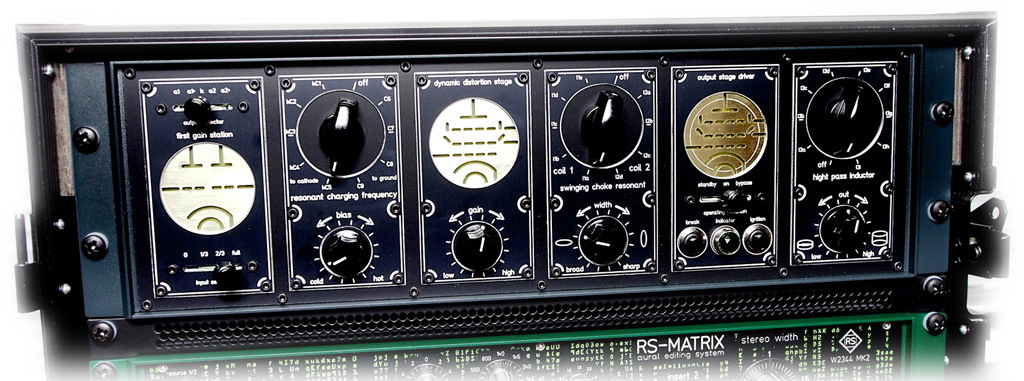|
U2379 tube distortion amplifier ( Prototype, not yet manufactured )
With the tube distortion "U2379" roger schult german audio lab introduces a mono-sound-design-tool, which uses the specific sound characteristics of different tube circuits in combination with coil filters in an unprecedented way.

Overview
The circuit of the distortion splits into three stages:
"first gain station" with "input selector" for adjusting the input signal and "output selector" for shaping the audio signal.
"dynamic distortion stage" - the heart of distortion with "bias" and "gain" for distortion range and "resonant charging frequency" and "swinging choke resonant + width" to design the sound.
"output stage driver" as impedance converter with rotary switch for the "output" plus a tone control "hight pass inductor" for damping the overdriven height components.
To start up the distortion, the functional unit "operating condition" is used by means of two buttons: "ignition" for starting and "break" for interrupting the mains voltage. A slide switch can be used to select between "on" and "bypass" function. The "standby" position protects the tubes and interrupts the operation.
Functional description
The distortion circuit is based on three tubes, which are used for the input stage, for the distortion unit and as an impedance converter in the output. In the input section, a double triode is used, so the input gain can be switched in four stages. With the additional 5-stage switch, different connections of the two triodes can be selected, in which five different tonal coloraturas are already provided at this point.
For the distortion, a variable-mu - penthode is used whose properties are very similar to a variable mu compressor circuit. The distortion comes about with the input level "gain" on the one hand and via the "bias" - ie the bias of the tube - on the other hand. Both parameters can be controlled by means of 12-stage ELMA switches. Furthermore a nine-stage ELMA rotary switch allows the selection of different coil networks, which act as resonators and thus directly affect the overdriving of the tube, and in the second coil network a quality control ("width") is involved . In practice this is achieved by distorting certain selectable frequencies earlier than others.
In addition to the obligatory level control, the output stage offers another rotary switch, behind which a filter module is concealed., which is also realized with a coil-based so-called hi-pass inductor circuit, This filter makes it possible to lower nine selectable frequencies of the upper middle range steeply. It can comfortably dampen the aggressive artifacts of the distortion stage without causing an undifferentiated sound image.
Overall, with these control options a hitherho unknown variety of sound results.
Videos
|